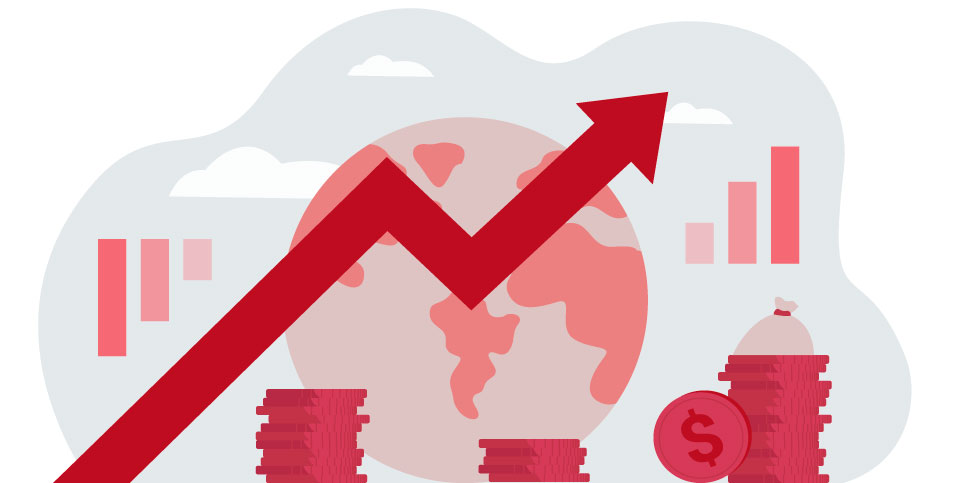Our latest investment update: First quarter market update for 2021

The first quarter of 2021 was always expected to be met with volatility, as global equity markets looked for positive news and a path out of the pandemic. We examine how it has unfolded.
The US markets
In the US, cyclical stocks (stocks that tend to follow economic cycles) have continued to perform well as they move away from stocks that have more growth characteristics, which started to fall out of favour. Key drivers of the outperformance of the market can probably be attributed to the large-scale fiscal stimulus package, monetary policy support, the successful roll-out of a COVID vaccine and the potential for the return of inflation later this year1.
In the UK – increased demand for equities
UK equities, just like their counterparts, have also fared well in this economic recovery, with sectors such as materials, energy and financials all showing strength in bouncing back. As the UK begins to re-open its doors to the world once more, the expectation for more demand will continue2.
The EU equity market
Equities in the EU made notable strides in Quarter One (Q1), with sectors that lagged significantly during the COVID crash showing signs of recovery. Energy and financials have led the way. Underperformers relative to the overall market recovery have been defensive areas such as utilities, which still see demand from consumers throughout the economic cycle3. As the EU equity market continues to make a sustained recovery, helped by the several stimulus packages phased in throughout 2021, we hope the recovery will continue, despite the path not being clear.
Asia
MSCI Asia Ex-Japan Index has recorded a positive return, with consumer optimism returning at the prospect of economic normality. Although equities have shown some strong performance, sentiment has diminished since the start of Q1. This has been due to slower vaccine rollouts which have ultimately led to further lockdown measures in some countries, unlike Taiwan and Singapore who were quick to put strong measures in place allowing for their economies to see a resurgence. Overall growth has been net positive. However, reasons for economic recovery lag include slow rollout of the COVID vaccine, regulatory uncertainty for certain industries and overall geopolitical concerns which have mellowed out positive sentiment thus far4.
Emerging markets
Emerging markets, along with equities across the board, have, on average, seen an encouraging turn around since the lows of March 2020. Although Q1 was a healthy quarter, slow vaccine rollouts compared to developed markets has ultimately led to a reduction in overall performance. New cases are still rising daily, necessitating further restrictions in some countries. With increases in US Treasury bond yields, this has put pressure on the higher growth areas of the equity market, along with the increasing strength of the US dollar5.
After losing ground to growth stocks early in the quarter, value stocks have taken the lead in terms of overall quarter performance. Industries with a lean towards value, such as IT and semiconductor producers, continued to flourish. This has come directly from a surge in demand for computer chips, used in everything from smartphones to cars6. Due to large scale manufacturers still not being fully operational, semiconductors have remained in short supply, resulting in a hoarding type mentality. This has helped to drive price up, but as companies become smart and work around such issues, maintaining such performance will be called into question.
Examining the bonds markets
The bond markets have proved unusually interesting over the first quarter. Yields on 10-year US Treasuries (US government bonds) have risen from just under 1% at the beginning of January to 1.74% by the end of the quarter7. As yields move inversely to price, this highlights that people are selling bonds as the economic picture improves elsewhere. In the UK, the move in yields was also significant. The UK 10 Year Gilt yield increased by 65 basis points to 0.88%. With the vaccine rollout slower in Europe, the rise in yields has been less significant. German Bunds saw a rise of 0.24%, which still kept them negative at -0.33%8.
A rising tide: growth vs value
Investors have been heralding the return of sustained value outperformance for over a decade, but rotations have been short-lived, despite the burgeoning performance gap between the two investment styles in recent times 9. Growth companies tend to be companies that show accelerated growth, whilst value companies tend to be ‘unloved companies unloved by the market’. However, the distinguishment of value and growth is contested and, by using valuation metrics, growth and value companies can exist within the same industries.
We prefer to look at the recent rotation from a cyclical and non-cyclical perspective. The rising tide lifts all boats, and whilst the first quarter was strong for equities, it is the cyclical stocks, which are highly sensitive to the business cycle, that continue to outperform. Many of the industries that suffered at the height of the pandemic, such as financials, oil and gas majors, and companies processing raw materials, all stand to thrive in a growing economy.
A greener US?
After 107 days out of the agreement, the US re-joined the Paris climate agreement as one of the first acts by President Joe Biden to affirm his focus on tackling climate change10. In March, the $1.9 trillion American Rescue Plan received the Presidential signature11, and although it wasn’t completely devoid of climate-friendly plans, it failed to fulfil the promises of rebuilding after COVID-19 with cleaner energy and a lower carbon footprint. The President instead promised a larger green infrastructure bill at a later date, which will be needed to make many of the President’s sustainable pledges financially viable.
The stimulus packages led to upgraded growth forecasts, paving the way for a steeper recovery through a multitude of policies, ranging from direct payments to small business grants, whilst adding to the national debt12. It is not the nominal value of the national debt investors are concerned with, after all, we are in an era of ultra-low interest rates and therefore the cost to service the debt is extremely low, but it is the potential inflationary pressures that may cause concern. Currently, the Federal Reserve believes any bump in inflation will be transient, pledging to maintain rock-bottom rates for the next three years13.
The economics of biodiversity
The Dasgupta Review, commissioned by the UK Treasury, was published by the University of Cambridge in February. It affirmed what is already widely known; that we cannot continue our current environmental trajectory. The report makes it clear that urgent and transformative action needs to be taken now. We must urgently increase the global supply of natural assets, increasing protected areas, and curbing damaging forms of consumption, calling upon the very government that commissioned the review to stop exacerbating the problem through subsidies that damage nature.
What separates the review from other research highlighting the ecological toll inflicted over past decades, is the conceptual framework for how nature and environmental factors can be incorporated into economics and decision-making. Gross domestic product (GDP) has long been the broad scorecard measurement for economic health, but with no accountability for environmental assets, it is easy to see how decision-making has, and could continue to, prioritise growth at the expense of nature. A new statistical standard, that will measure the worth of natural “dividends,” from fish stocks to reduced health burdens from purified air, is promoted to end the reign of GDP, and bring forth an era of ecosystem accounting14.
The road to recovery
As we’ve mentioned before, the vaccine and the pace of vaccination are likely to play a huge part in the ‘road to recovery’. Considering the announcement of the vaccine was late last year, it is both impressive and astonishing to think that globally more than 928 million vaccine doses have been administered15. In the UK, approximately 50% of the population have had at least one dose of the vaccine16, a figure beaten only by Israel where roughly 62% of the population has had at least one dose. Whilst the data may not be entirely accurate, studies from Israel show that the vaccination is leading to significantly reduced cases of COVID-19 amongst its population17.
The signs are good, and the numbers are moving in the right direction. We expect that if the vaccine rates continue in the same manner then some form of herd immunity is possible. Whilst the data and vaccine rollout for many countries are very positive there are some more worrying signs from Africa and India, where vaccines have been in short supply and the vaccination programmes far off the speed of much of the developed world18.
There’s been much progress, but there remains a long way to go.
1 https://russellinvestments.com/uk/global-market-outlook
3 https://am.jpmorgan.com/gb/en/asset-management/adv/insights/market-insights/monthly-market-review/
5 https://www.lazardassetmanagement.com/research-insights/outlooks/emerging-markets
6 Global shortage in computer chips ‘reaches crisis point’ | Technology sector | The Guardian
7 Quarterly markets review – Q1 2021 – Schroders global – Schroders
8 Investors shed safe-haven German Bunds as ECB fortifies the euro zone | Reuters
9 https://www.morningstar.com/articles/1017342/value-vs-growth-widest-performance-gap-on-record
10 https://www.whitehouse.gov/briefing-room/statements-releases/2021/01/20/paris-climate-agreement/
12 Larger Stimulus Leads to Big Upgrade to U.S. Growth Forecasts – Bloomberg
13 https://www.federalreserve.gov/monetarypolicy/fomcprojtabl20210317.htm
15 https://www.nytimes.com/interactive/2021/world/covid-vaccinations-tracker.html
16 https://ourworldindata.org/covid-vaccinations
17 https://www.bmj.com/content/372/bmj.n567
18 https://www.bbc.co.uk/news/56100076
We have received lots of positive feedback about our updates. If you’ve found them useful and informative, we would be delighted for you to share them with friends, family and work colleagues. We are always keen to spread the word about our unique approach to financial planning and investing.
Please note that any thresholds, allowances, percentage rates and tax legislation stated may change in the future. The content of this communication is for your general information and use only; it is not intended to address your particular requirements. This communication should not be deemed to be, or constitute advice. You should not take any action without having spoken with your usual adviser.


